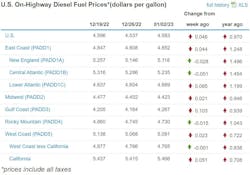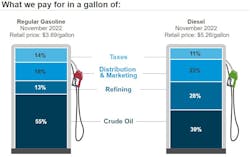The national average price of diesel fuel began 2023 on a higher note—but not the kind that the trucking industry would prefer. For the first time in two months, the industry’s main fuel is up: 4.6 cents to $4.583 per gallon, according to the newest U.S. Energy Information Administration (EIA) data.
The week-of-Jan. 3 diesel bump breaks a seven-week string of price breaks—in some weeks, in fact, the fuel dropped by double digits. The price declines, which were as much as 21.3 cents (and that left the fuel during the week of Dec. 12 cheaper than it had been since February), began to ease up last week when the decline in trucking’s main fuel was a comparatively slim 5.9 cents. The momentum did not, however, continue this week.
Motor club AAA had the national average for diesel on Jan. 3 up as well: 6.9 cents to $4.679 a gallon from the week before, with incremental increases all throughout the last week of 2022.
See also: Plug Power previews the potential of a green hydrogen highway
The EIA and AAA data leaves the U.S. average for diesel 97 cents higher (by EIA’s measure) and $1.108 more (according to AAA) than it was at the start of 2022. EIA collates fuel data week by week and by region of the country. AAA breaks the prices down by day, week, and state by state.
Gasoline also surged in price: 13.2 cents nationally to $3.210 per gallon. The pace of the decline of gas prices has been much greater in recent weeks than it has been for diesel. But the opposite happened the week of Jan. 3. And the national price increase for gasoline was moderate compared to some regions. Along the Gulf Coast, gas surged 20.7 cents, for example. In the Midwest, the increase for the week of Jan. 3 was 15.1 cents. Even with the surge this week, gas still is 5.8 cents cheaper than it was at this time last year.
Diesel increases extend to every U.S. region but one
According to EIA, diesel was higher for the week of Jan. 3 in every U.S. region except the Rocky Mountain region, where the fuel was down 1.5 cents to $4.730 over the week of Dec. 26. In every other region, the average was up slightly, except on the Gulf Coast, where diesel surged 10.3 cents to $4.267. Trucking’s main fuel rose 4.4 cents to $4.852 on the East Coast (though it was down slightly there in two subregions, New England and the Central Atlantic), up 2.1 cents to $4.423 in the Midwest, and 2.3 cents higher to $5.091 on the West Coast, the only region where the average is above $5 per gallon.
The now diesel price increases might be temporary, judging by per-barrel oil prices, which traditionally are the strongest barometer of the direction of several fuels such as diesel, gasoline, jet fuel, and home heating oil. Both West Texas Intermediate and Brent Crude were down about $1.50 a barrel on Jan. 3, and they’ve hovered consistently around or even below $80 per barrel since late last year after spiking to about $120 earlier in 2022.






